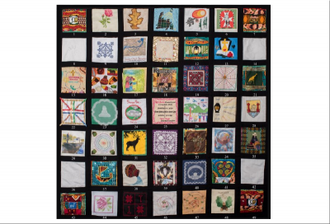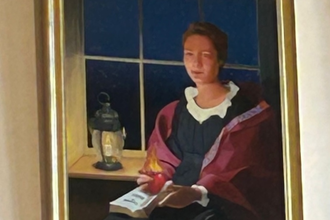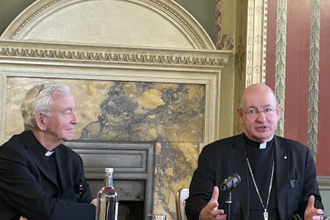Nano Nagle tercentenary commemorative quilt unveiled

A patchwork quilt commissioned to celebrate the tercentenary of the birth of Nano Nagle has been unveiled at Nano Nagle Birthplace at Ballygriffin, Killavullen, Co. Cork. The Nano Nagle Tercentenary Commemorative Quilt was commissioned because it was felt that needlework would be a fitting way to commemorate Nano as needle craft was one of the skills that she gave to girls in her early schools in Cork City. The creation of the quilt as a wall hanging involved Presentation Sisters and Friends of Nano from all over the world.
The quilt is comprised of 49 patches with each patch depicting and representing a community and a people who were touched by Presentation Sisters who have carried Nano's message across the world. The project was led by the Board of Management of Nano Nagle Birthplace. It was implemented by local woman and board member - Gertrude Magner, assisted by Killavullen Patchwork Group members - Hilary O'Kelly and Julia Sheehan.
A unique feature of the quilt is that women from many countries with a strong connection to the message of Nano Nagle sat and worked on beautiful fabrics using the skills of their native culture. The network of patches represents the network of Presentation Sisters throughout the world and depicts their ethos of being 'in communion'. Patches were received from Ireland, England, Slovakia, Zimbabwe, Zambia, India, Pakistan, the Philippines, Thailand, Holy Land, New Zealand, Latin America, USA and Canada.
Types and Style of Patches
The patches vary in fabric, thickness and style, and show the skills in needlecraft of the country or region from which they came. Some examples are patchwork from Africa, hand embroidery from India, machine embroidery, Carrickmacross Lace and Mountmellick Embroidery from Ireland, crochet, applique, and sequins work. The diversity of materials, styles and colours is noteworthy. Patches range in craft from the most ancient one of weaving to the 21st century one of computerised embroidery and the digital photography.
History of the Presentation Sisters in Needlework
Sr Mary Hoare, Director of Nano Nagle Birthplace said that the great response to the invitation globally to submit patches bears witness to the history of Presentation Sisters in craft work. "In the past" she said "many of our schools had needlework skills included as an integral part of their activities, and some, for example South Presentation Cork, Youghal, Thurles and Galway had a separate lace school attached".
In 1825, the first Report of the Royal Commission on Education referred to the curriculum in the Presentation School in Galway as including 'needlework such as Limerick lace, Irish point and crochet' as vocational and technical skills training. John Barrow in his 'Tour Round Ireland' in 1835 also referred to girls being "taught needlework" at the school.
In 'History of Ireland in 100 Objects' in the Irish Times on 6 October 2012, Fintan O'Toole wrote: "Youghal Lace Collar, 1906: This exquisite needlepoint lace collar, made in Youghal, Co Cork, and exhibited at the Royal Dublin Society in August 1906, epitomises one of the more remarkable achievements of Irish women in the second half of the 19th century: the creation from scratch of a world-class craft industry." The article explained how Sr. Mary Anne Smith developed the craft of lace making in the Presentation School in Youghal in 1847 and how it spread from there to schools in Kenmare, New Ross, and other towns as part of Nano's legacy.
Speaking at the Un-Veiling Ceremony, Indian-born Sr. Aurea Dias of the Congregational Leadership Team said: "This quilt attracts us because piece by unique piece, stitch by stitch, shade by nuanced shade it reveals a story. Each patch carries the story of a people, their culture, their identity, their life. It is a symbolic web, a mystical story that weaves the originating past with the living present and hopefully awakes us into the emerging future.
"Here, in this place is where it all began over 300 hundred years ago. A spark was captured in the person of Nano Nagle whose dream 'if I could be of service … in any part of the globe .." was carried by brave pioneering sisters from Ireland who ignited it on five different continents - Europe, North America, Asia, Africa, Australia / New Zealand, and Latin America.
"This quilt creatively brings together as one, all that diversity and rhythm of life from 23 different countries and grandly presents itself before us, as a feast for the eye of body and spirit. Fulfilling yet another dream of Nano: 'there is no greater happiness than to be in communion'. Out of this quilt flows the meaning of the Presentation family. Just like these pieces that make up the quilt. The Presentation family and the Presentation sisters founded by Nano Nagle is a tapestry of exquisite difference, of exotic uniqueness, of vibrant human beings, that defies exclusion, discrimination of smallness of heart.
"Within this beautiful piece of art, the mystery of God's love is held. The same mystery that holds us all together like a kaleidoscope. Our very nature, the fabric from which we are created, the charism on which we are nurtured, is fed by the powerful energy of the universe that calls our uniqueness and our diversity into oneness of mind, heart and spirit. And that is our heritage, our spirituality, the spirituality of being in communion. Brothers! Sisters and the whole earth community! We are but one precious quilt!
"And, here we all are a living quilt that grows and changes, weaving other patterns, sewing other quilts, harmonising differences, knitting together relationships, bring close that which is afar, discovering in challenges the wings of possibilities. This quilt gathered us together here, and now sends us for the like Nano Nagle to build other quilts of love and service" she concluded.
History of Quilting
Gertrude Magner, who initiated the idea of the quilt, spoke of the history of patchwork which originated during the Napoleonic wars when soldiers and prisoners used old uniforms to make patchwork blankets. "The 17th century" she said "was the heyday of quilting in Europe when silk was used to make waistcoats, jackets and petticoats which became popular day-wear. In the 18th century, quilting became a ladies' leisure pursuit and cottons were used to make large quilts
"In the 20th century with two world wars saw patchwork - wool and cotton - growing for bedding and clothing due to the scarceness of other fabrics. Then in the 21s century, the Quilters' Guild was formed, and with copies of traditional and new modern designs, many quilts became wall hangings, and that is what we have done with this quilt. This tercentenary commemorative quilt is unique because the patches all carry another craft ranging from traditional patchwork to embroidery to modern techniques of computerised embroidery and print" she told a very interested audience" she said.
Quilt on Display
The relevance of a patchwork quilt in commemorating Nano Nagle is obvious. The quilt will be on display at Nano Nagle Birthplace for visitors to admire and appreciate the skills, the expertise, the cultures, and the dedication to craft and detail that were shared by so many people who were involved in the making of this patchwork quilt as a fitting remembrance of the founder of the Presentation Sisters in 1775 in Cork City. It is accompanied by an information booklet explaining the source and meaning of each of the 49 patches. This booklet can also be read on www.nanonaglebirthplace.ie. Nano Nagle Birthplace is located 9kms from Mallow on the road to Fermoy in Co. Cork. Summer opening times are Tuesday to Sunday from 10am to 6pm.
(Matt Moran is a member of the Board of Management of Nano Nagle Birthplace. He is a writer based in Cork and author of book - The Legacy of Irish Missionaries Lives On - available from www.onstream.ie)


















